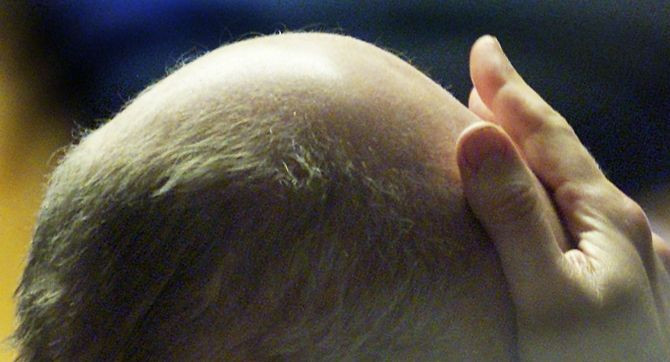Severity of Male Pattern Baldness May Predict Prostate Cancer Risk

Bald men may have a higher risk of developing prostate cancer, according to new preliminary study.
Researchers, presenting at the American Urological Association annual meeting in Atlanta on Tuesday, found that biopsy samples taken from bald men were more likely to have cancer than samples taken from others with more hair.
"Bald men should be aware that they may benefit from being screened earlier and perhaps, if necessary, from being biopsied sooner," said researcher Dr. Neil Fleshner, a professor of surgical urology at the University of Toronto, according to HealthDay.
"In the study, the more bald people were, the more likely they were to have prostate cancer. We're 95 percent sure this is real," he added.
Findings from previous research have also linked male pattern baldness to prostate cancer, and while the precise cause has yet to be determined, scientists think male hormones, or androgens, play a role in both baldness and prostate cancer.
One possibility is that androgens, which include testosterone, dihydrotestosterone and androstenedione, inhibit hair growth and trigger the development of prostate cells.
In bald men, when levels of the androgen dihydrotestosterone (DHT) increases, hair follicles shrink gradually, and as follicles get smaller, hair weakens and eventually stops growing.
Researcher studied 214 patients between the ages of 59 and 70 years who had elevated prostate cancer risk or higher prostate-specific antigen test numbers and had been referred for a prostate biopsy. Men with normal PSA numbers were not included in the study.
Baldness was assessed on a four point scale, mild frontal balding, mild vortex or top balding, moderate vortex or top and sides balding and severe vortex or top and sides balding, before biopsies were taken.
Using multivariable analysis, researchers found that male pattern baldness was a significant predictor of prostate cancer. Additionally, they observed a dose response effect between severity of baldness and prostate cancer risk, and participants with more severe balding patterns were more likely to have prostate cancer.
Researchers point out that while the study did find correlation between baldness and prostate cancer risk, it did not prove a causal relationship.
While previous studies found a link between the relative length of a man’s index and ring fingers and prostate cancer risk, researchers from the latest study found no such association.
"In a prospective cohort we found that male pattern baldness was an independent predictor of prostate cancer. Further studies are needed in order to assess whether the inclusion of male pattern baldness can contribute to existing models to predict prostate cancer prior to biopsy," researchers concluded.
However Dr. Nelson Stone, a clinical professor of urology and radiation oncology at Mount Sinai School of Medicine in New York City said that researchers should have examined more closely the association between the amount of hormones, like testosterone and DHT, and prostate cancer risk, instead of looking at baldness.
"The incidence of baldness goes up with age, and we know that testosterone levels fall with age, and we still don't know why," Stone said, according to HealthDay.
Stone also noted that researcher failed to address whether the men who had a positive biopsy had predominantly aggressive or nonaggressive forms of prostate cancer.
Dr. Tobias Kohler, an American Urological Association spokesman for the, said that all men should be aware of prostate cancer, regardless if they have or don’t have hair on their heads.
"There is a link between baldness and prostate cancer, but it could be due to some other factor -- perhaps something in the environment or something genetic," Kohler said, according to HealthDay. "I would approach this study with caution."
Published by Medicaldaily.com



























